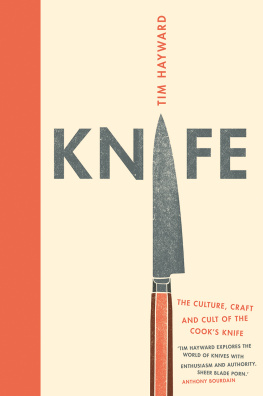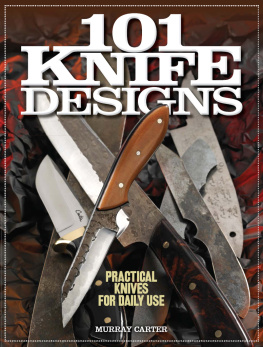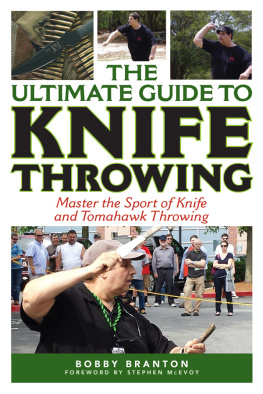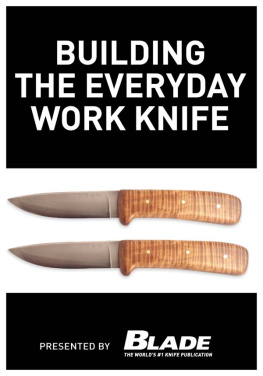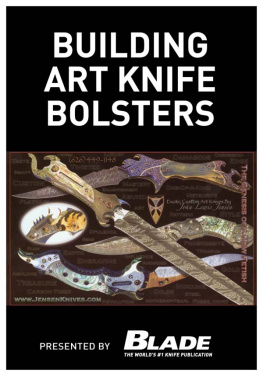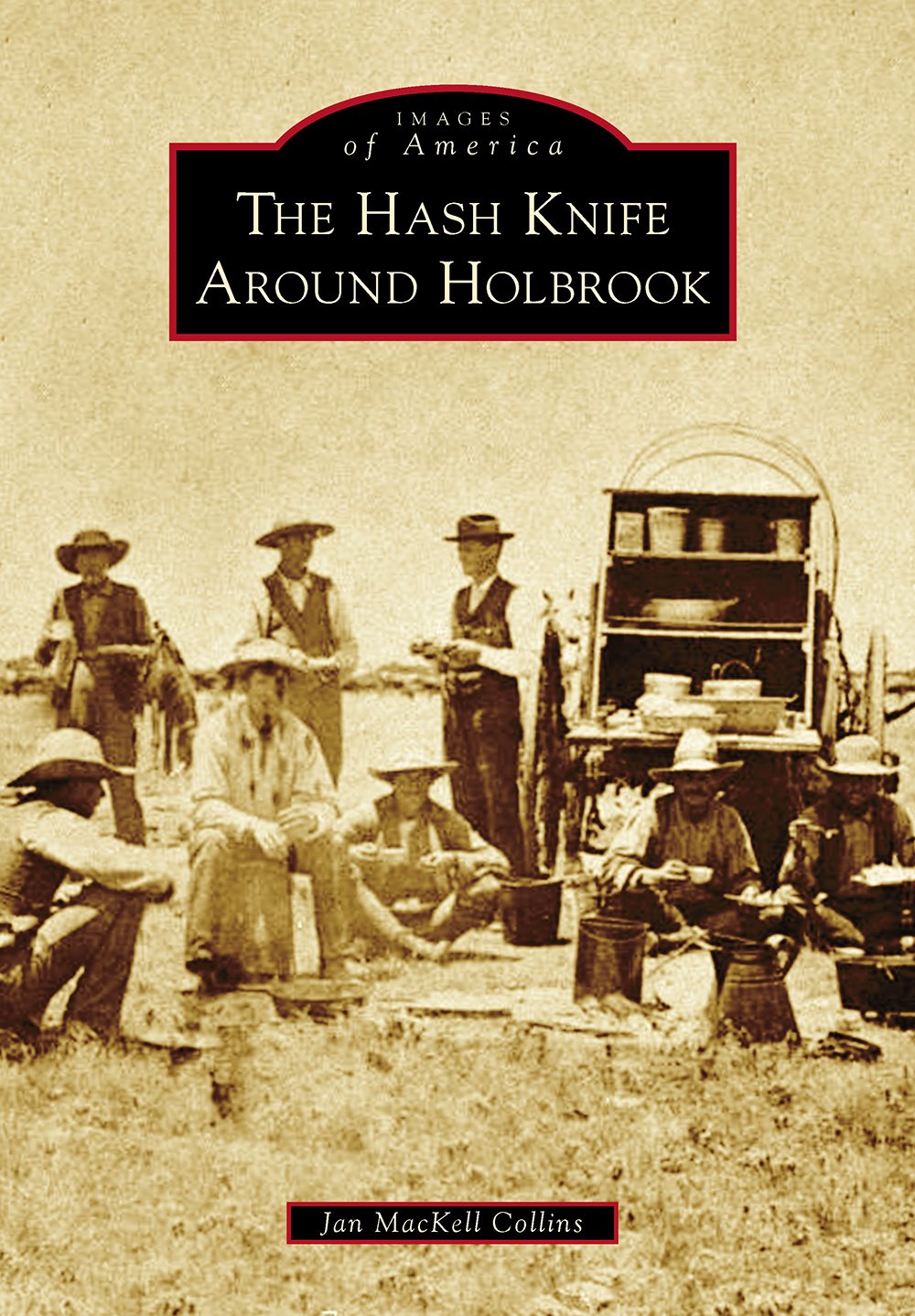
IMAGES
of America
THE HASH KNIFE
AROUND HOLBROOK

The Aztec Land and Cattle Company was comprised of some 2 million acres at its peak. The range included headquarters in and near Holbrook and Joseph City, and spanned as far south as Payson. Hash Knife cowboys traveled by horseback between the four headquarters, eight official line camps, and a number of other more primitive camps as part of their daily duties. (Jan MacKell Collins.)
ON THE COVER: Although the Hash Knife is best known in Arizona, the brand had its beginnings in Texas. John Nicholas Simpson moved to Weatherford, Texas, from Tennessee in 1866, operating a dry goods store before turning to ranching. He relocated to Taylor County in 1872. His first brand, the Long S, was soon replaced by that of a hash knife: a common cooking tool whose brand was difficult to alter. At least a few Hash Knife cowboys, such as these men pictured in Taylor County in 1880, later moved with the brand as operations expanded to Montana and finally Arizona. (Abilene Photograph Collection, Hardin-Simmons University, Abilene Texas.)
IMAGES
of America
THE HASH KNIFE
AROUND HOLBROOK
Jan MacKell Collins

Copyright 2014 by Jan MacKell Collins
ISBN 978-1-4671-3093-6
Ebook ISBN 9781439649985
Published by Arcadia Publishing
Charleston, South Carolina
Library of Congress Control Number: 2013940974
For all general information, please contact Arcadia Publishing:
Telephone 843-853-2070
Fax 843-853-0044
E-mail
For customer service and orders:
Toll-Free 1-888-313-2665
Visit us on the Internet at www.arcadiapublishing.com
For Papa, DeDaddy, and Dad
CONTENTS
ACKNOWLEDGMENTS
Writing about your own family can be a little scary. It is one thing to write history and hope you have your facts straight. It is quite another to write history about your relatives and hope you are not banned from all future family functions.
That being said, I am extremely grateful to my relatives who contributed their advice, criticism, knowledge, and photographs to the writing of this book. They include my dad; my cousins Suzanne Peterson, David Moritz, Kris and Graham Wontney, and Joe Ramos; my other mom, Barbara Espino; and my amazingly patient husband, Corey.
None of us would have such a good grasp of our family history without the diligent recording of it by our ancestors. I am particularly grateful to Cora Taylor Forbes Wallace, Frances Wallace Hennessey, and Evelyn Mae Hennessey Smith for carefully saving everything for my family to enjoy. Aunt Betty, Uncle Charlie and Aunt Marian, Aunt Berba, Aunt Dude, Amy Wallace, and many others also played an integral part in preserving our family history. I also thank my mother, Eleanor, for making sure I listened to all the stories. Thanks to them, most of the images in this book are being provided by myself and my family unless otherwise noted.
I also wish to thank Jolynn Fox at the Navajo County Historical Society in Holbrook; Lita Slaggle at the Baylor County Free Library in Seymour, Texas; Grace McNellis of the Vandervert Ranch in Oregon; and Chioko Hammel of the Carter County Museum in Ekalaka, Montana, for their help and for sharing their materials for this project. My dad and I are also indebted to Ed Delph and Larry Boeschling for allowing us a tour of the beautiful OW Ranch as it stands today.
Dozens of books and articles out there give the writers best perspective on the history of the Hash Knife. Without these histories, the truth and legend behind the brand might have been forgotten. I am very appreciative of those authors who have set a precedent and offered their own interpretations of the outfits history.
INTRODUCTION
The Hash Knife brandfashioned after a common cooking tool popular among camp cooks and ranch wiveshas been a staple of cattle history for roughly 140 years. Established by John Nicholas Simpson in Texas, the brand has served ranches in Montana, Arizona, and beyond. Companies who owned the brandnamely the Continental Land and Cattle Company, the Aztec Land and Cattle Company, and Babbitt Brothersfunctioned as some of the largest and most profitable organizations of their time. Between 1878 and 1901, five large-range ranches were established using the Hash Knife brand.
Through the years, the brand has taken on a romance of its own. The admiration seems equally shared by those who worked for the Hash Knife, those who know of someone who did, or those who wish they had done so themselves. The picture or even a memory of cowboys roping cattle on the dusty prairies or gathering around the chuck wagon evokes a sentimental love for the cowboy way of life. Forget that working on the range was hard and often dangerous. To those men who did it, working cattle was worth the risk and gave them some of the best memories of their lives.
In fact, the Hash Knife seems to have grown into its own symbol of cowboy life. During the last century, the name has come to identify any cowboy, ranch, or company associated with the brand, and there were plenty of them. The men of the Hash Knife ranged from studious businessmen from New York, to hard-working cow punchers, to rustlers and outlaws. The rustlers and outlaws are of particular interest to history buffs, since they add a bit of color to the story.
It is true that by the 1880s, the Hash Knifes association with the notorious Millett brothers in Texas, plus a shootout in Montana, had somewhat tainted the brands good name. When the Aztec Land and Cattle Company was formed to bring the Hash Knife to Arizona in 1884, the owners likely hoped the outfit would shed itself of its unsavory reputation. Some of the hands had been with the brand since the beginning. Many of them were good, hardworking men. A few others were not.
The Aztec, as it was often referred to, acquired 2 million acres between Holbrook and Flagstaff. The cattle had hardly settled in before stories began circulating about rowdy cattle thieves, drunks, and robbers terrorizing Holbrook. Their well-publicized exploits eventually inspired authors Zane Grey, W.C. Tuttle, Clarence W. Durham, and others to expand on the boys daring adventures and write fictional novels about them. The Hash Knife soon became, and remained, a fascinating entanglement of fact, fiction, and folklore.
By the time Burton C. Cap Mossman was hired as superintendent in 1898, rustlers and outlaws did seem to be rampant around the Hash Knife. Mossman set to work cleaning house, firing half the crew within a month. He was assisted by foreman Benjamin Franklin Frank Wallace, with whom he had worked in Texas and hired soon after joining the Hash Knife. Wallace in turn hired cowboy George W. Hennessey, and the three men became lifelong friends.
By 1899, there were some 30 hands working for the brand. There is no denying that a few questionable characters may have still been in the group, but by then the good guys far outweighed the bad guys. The Hash Knife had the name of being a hard drinking, hard fighting outfit, Hennessey later remembered, but I never worked with a better bunch of men.
Good or bad, the cowboys of the Hash Knife worked hard. The Aztec had suffered through a particularly hard winter in 1898 and was now combating feed shortages and a four-year drought. After 17 years of owning the Hash Knife brand, the Aztec sold out to Babbitt Brothers of Flagstaff. It took about a year to settle matters and ship out the cattle, after which Cap Mossman resigned. Wallace and Hennessey followed suit within a few years.
Next page



